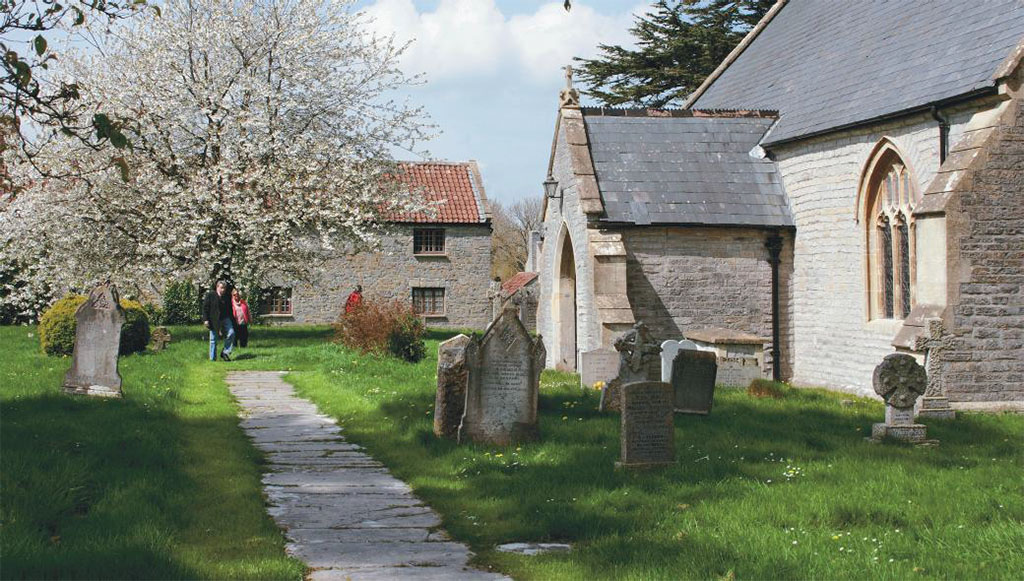
The Avebury stone circles (there are three distinct circles on the site) are the largest in Britain, and considered by many to surpass even Stonehenge in grandeur. While at first glance, the complexity of the design of Stonehenge seems to overshadow that of Avebury, the most impressive features at Avebury are those that are most modest at Stonehenge.
The first thing to strike visitors to Avebury is not the stones, but the surrounding bank and ditch. Originally, the ditch reached a depth of 30 feet, and the adjoining mound stood 18 feet high. While erosion has taken its toll, the henge still dwarfs the nearly vanished earthworks at Stonehenge. At about a mile in circumference, the Avebury henge completely encircles a small village, and even the smallest of the three stone circles within is still larger than Stonehenge.
From a distance, the individual stones at Avebury do appear less impressive than those at Stonehenge, but this is mostly an illusion caused by the size of the circles, and also by the fact that so few of the original Avebury stones remain. Of the two inner circles, only four and five stones still stand, respectively. The third circle remains only marginally more complete, with 27 of the original 98 stones still in place.
Much of the destruction at Avebury was deliberate, even systematic, and occurred as recently as the medieval period. Apparently, the church held a dim view of what it considered to be a pagan temple, and in its efforts to suppress persistent pre-Christian traditions, it destroyed some of the stones by heating them with fire, and then dousing them with cold water so that they cracked. Other stones were simply toppled and buried on site. The destruction was not always without mishap. A medieval skeleton lay under one of the buried stones, apparently belonging to a doctor who was standing in the wrong place when the stone fell prematurely. Some of the toppled stones have been set upright once again. But many of the sites where the stones once stood are marked only by modern posts.
The three circles were laid out in an unusual manner. In contrast to the concentric elements found at Stonehenge, Avebury features two smaller, nearly perfect circles arranged side by side within a third, much larger circle. The larger circle is far from perfect, and one explanation posits that the inner circles were built first, perhaps using a rope tied to a post to measure off a fixed distance from the centre. When the outer circle was added, the stones of the first two circles would have made this method impossible, forcing the builders to make a crude approximation.
The megaliths used in each of the three circles were left undressed, although the builders obviously selected them with an eye towards their natural shape. As with many similar sites throughout Britain, the stones are of two distinct types: straight-sided pillars (thought by some archaeologists to represent the male aspect) and diamond-shaped (possibly representing the female).
Today, many visitors who have travelled both to Avebury and Stonehenge find that the former's more sympathetic setting contributes greatly to its grandeur; but in the past, Avebury suffered even greater indignities at the hands of modern man than its famous cousin. When he began the first extensive excavations in the 1930s, Alexander Keiller wrote of finding 'conditions of indescribable squalor and neglect prevailing over most of the area . . . indeed the tangle of rusty pig-wire, the accumulations, to a depth of nearly three feet of old tins and broken bottles, around two of the standing stones, to say nothing of the refuse heaps which filled the ditch almost flush with its edges, constituted ungenerously towards rendering the once majestic site of Avebury what it had been for centuries, the archaeological disgrace of Britain'.
Keiller did the work not only of a researcher, but also of a restorer, clearing the ditch, resetting many stones in their original holes, piecing them back together from the fragments he found, and tearing down unsightly outbuildings within the circle.
Avebury is one of a series of apparently related ancient monuments, including Silbury Hill and the West Kennet Long Barrow, as well as two avenues lined with standing stones that seem to have formed processional ways between the Avebury circle and other nearby circles.
The Avebury stone circle surrounds the small village of Avebury at the junction of the A4361 and B4003 roads. Visitors are welcome at any reasonable time, and admission is free. Parking is available in the village. The small Alexander Keiller Museum contains artefacts unearthed within the circle, as well as at nearby Windmill Hill. Tel: 01672 539250.









Comments